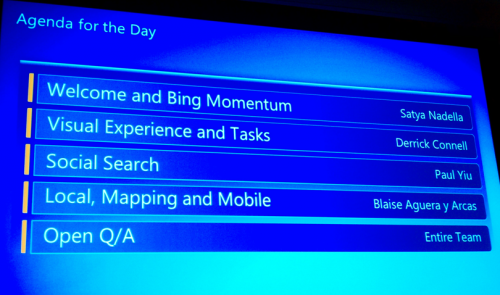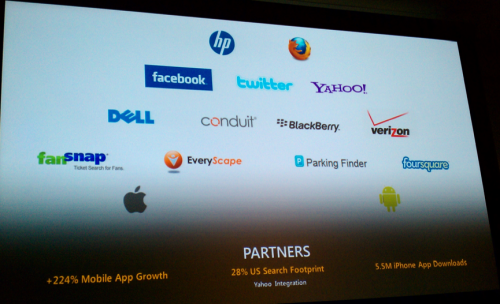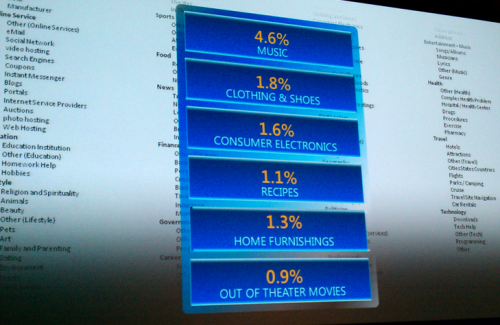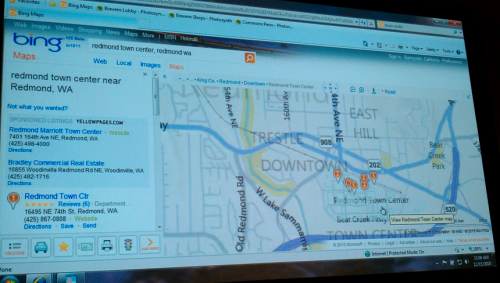Live Blogging the Bing Search Summit
I’m in San Francisco waiting for the start of the Bing Search Summit. There are a huge number of things rolling out this morning. It will be interesting to see what they emphasize and demonstrate here at the event. I’m not the master of live blogging that Danny is but I’ll do my best to […]
I’m in San Francisco waiting for the start of the Bing Search Summit. There are a huge number of things rolling out this morning. It will be interesting to see what they emphasize and demonstrate here at the event.
I’m not the master of live blogging that Danny is but I’ll do my best to capture the major announcements. The event begins at 10 Pacific/1 Eastern. Check back for updates.
Microsoft’s Satya Nadella is up welcoming people to the summit. He’s describing their update cycle. Here’s the agenda for today:
Bing Market Update:
11.8% explicit share; up 48% since launch. They’re up 72% with heavy and medium users. Now over 90M users, grown 27 million users since launch. They over index in the 18 to 24 age range.
Nadella says he’s most excited about their new enthusiastic users: heavy and medium users. In the young age range 40% are willing to recommend Bing. He touts a number of metrics (e.g., task completion) that indicate people are satisfied and Bing is making progress.
Bing over-indexes for vertical search. Vertical searches on Bing have grown 97% vs. 4% for the overall market.
Partnerships include Facebook, Twitter, Yahoo, EveryScape, Foursquare, HP, Firefox, BlackBerry and others. Nadella is discussing toolbar deals, giving Bing a foothold and helping them “move users up the funnel.”
Nadella: “We’re neck to neck in terms of search quality.” It’s a function of the “throughput of experimentation.” “We’ve invested a lot to run experiments at scale.” Now moved to a new technology “boosted decision trees” that will help MSFT improved specialized search.
“Pillars” of Bing search:
In addition to search quality here are the “pillars” of Bing search:
- Visual organization: This is what helps differentiate Bing from Google. Nadella disputes the idea that visual and UI features are “eye candy.”
- Task centric: This makes Bing different and helps users get things done.
- Social: Nadella talks about the impact of social on search. Social will change search fundamentally in how people discover information. “We’re at the very beginning stages . . . it could be as big as anchor text or linking was to search.”
Visual organization: This incorporates huge amounts and varieties of data, not just documents. All visual placements are dynamic. Nadella is discussing the various challenges of presenting and highlighting information visually. “We continue to pioneer alternative methods of formulating search queries.”
Task: 70% of non-navigational search queries can be classified into 155 query segments. Here’s how they breakdown:
What are people trying to get done? Nadella describes how MSFT analyzes consumer behavior and intent.
We’re now getting an update on some of the visual improvements — new image search goes live today. Now reviewing visual search, launched a year ago. It’s growing 2X to 3X over the past several months. It’s a way to browse content.
Visual information and “answers”:
Visual information presented in “answers” (onebox). Categories of answers have been expanded. There are new dynamic answers launching. Now hearing lots of discussion of the technical and machine learning challenges of placing visual answers. Answers are now “smaller and prettier.”
Now seeing and hearing about several different query example types and how “answers” are formulated and populated. Now hearing about how determining intent leads to presentation of dynamic answer and additional information around it:
Image search:
New image search is being shown: large and small views, improved left navigation, smart tabs that are contextual . . . This is pretty useful and rich. Lots of UI improvements.
Now seeing improvements in product search, automotive, TV, “travel destinations” and other verticals a representations of “task completion.” MSFT includes contextually or vertically relevant content in search results depending on the query category.
(Information overload — it’s coming at me too quickly.)
All of the examples being showing reflect clustering of information on SERPs around query and ability to transact or complete tasks (e.g., watching movie trailers, buying tickets, making reservations).
Social:
The social graph is a “web of people” as opposed to a “web of documents.” This is alternative ranking methodology. MSFT going to integrate “Like annotations”: the influence on results and search quality by people in your social graph. We’re now getting a review of how Facebook integrates into Bing results.
Social annotations are “Likes” showing up in Bing SERPs. They are influencing ranking on Bing and will lead to personalized search rankings. In addition, social annotations/Likes help generate more clicks “down the page.”
Nadella returns to the podium: The “notion of search quality foundationally influenced by the social graph.”
Mapping and Local (geo-spatial):
Nadella discussing general improvements in local and mapping and references EveryScape deal and integration into Bing local profile pages. Now discussing mobile and repeating a number of stats that have been released before, including more than 50% of mobile searches have a local intent.
Now up to discuss Bing Maps is Blaise Aguera y Arcas. New HTML5 and AJAX versions of Bing Maps bring more of the Silverlight functionality “out” and make it accessible to the browser and a broader audience. Map Apps are also being brought into the main site (though not entirely).
Bing Maps is bringing in much more information into maps “at the human scale.” Task can be completed on profile pages (e.g., OpenTable) Now showing EveryScape integration:
Now he shows iPhone app “panorama creator” that enables users to create EveryScape-like tours that can be uploaded (and potentially integrated into Photosynth).
We’re seeing Bing mobile search assist on the iPhone and the related content and capabilities.
Microsoft is also releasing its Street View competitor Street Side on mobile. It has some very user friendly capabilities, giving people the ability to look at a panorama of the surrounding area quickly.
He’s discussing public transit and directions. He’s also introducing check-ins and demo’ing several other maps/mobile features.
Blaise says that the cluster of capabilities and improvements in Bing now constitute “Search 2.0” (interaction with search vs. passive consumption). He’s also showing Bing image search or visual search using the mobile camera integrating OCR (like Google Goggles/Shopper):
Q&A:
Question about whether Bing will develop its own version of “Instant.”
Nadella: We’re studying Google Instant and trying to decide whether to “match it.” He dismisses the technical challenges but wonders whether it helps “around task completion.” Is it of value or “a distraction.” As a universal solution for every query “it probably gets in the way.”
Question about Facebook integration and decision to sign in or not with Facebook:
We’ve seen the quality of Likes improve. Nadella: one of the key things about the partnership is the instant personalization of search results. He adds that one about of 5 Bing users gets personalized results (if they’re Facebook users and logged in). The question of how it has or hasn’t impacted Facebook log-ins is not answered (probably misunderstood).
Question: Are publishers eager to work with Bing to diminish Google’s power?
Nadella returns to theme of “task completion.” He rhetorically asks: are the algorithms “fair” and do they have “integrity”? But he largely sidesteps the question.
Question: Asking for more detail about Bing check-ins.
It sits on top of existing check-in systems. Nadella says look at m.Bing.com; it looks just like the apps. Accordingly, MSFT says that it will be focusing on the mobile browser more going forward.
End of session.
Opinions expressed in this article are those of the guest author and not necessarily Search Engine Land. Staff authors are listed here.
Related stories












